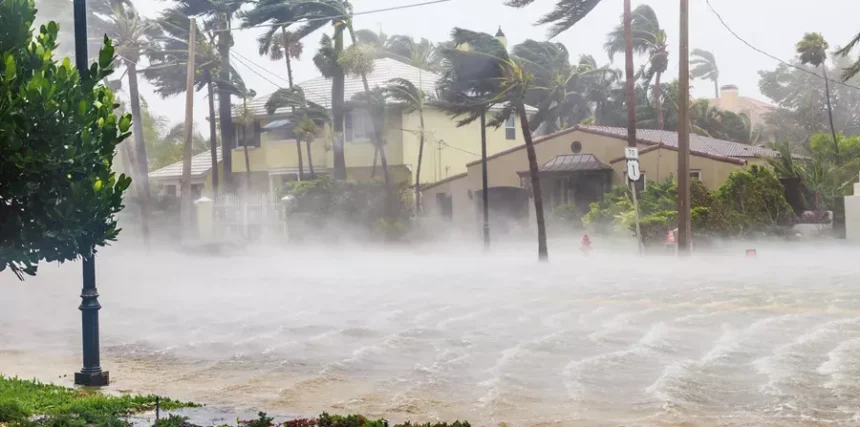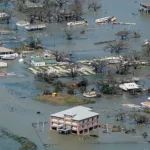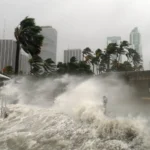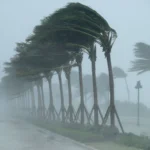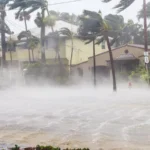As Florida braces for another hurricane, understanding the projected path of the storm is crucial to ensure the safety of residents, businesses, and infrastructure. With advanced meteorological technology, we can now predict the movement of hurricanes with greater accuracy. This article provides an in-depth look at the projected path of the latest hurricane threatening Florida, based on real-time data, expert analysis, and historical trends.
1. Current Location and Strength of the Hurricane
As of the latest update from the National Hurricane Center (NHC), the hurricane is located approximately 300 miles southeast of Miami, Florida. The storm has intensified over the last 24 hours, with maximum sustained winds reaching 120 mph, classifying it as a Category 3 hurricane.
The storm is moving in a northwest direction at 12 mph, and meteorologists predict further strengthening as it approaches warmer waters in the Gulf of Mexico. Forecasters are closely monitoring the hurricane’s eye as it becomes more defined, indicating potential intensification over the next 48 hours.
2. Projected Path Based on Current Models
The projected path of the hurricane is determined by various forecast models such as the European Centre for Medium-Range Weather Forecasts (ECMWF) and the Global Forecast System (GFS). These models help predict the trajectory and potential landfall of the hurricane.
According to the latest models:
- The GFS model indicates a north-northwest trajectory, with potential landfall near Tampa Bay within the next 72 hours.
- The ECMWF model suggests a more westward track, possibly steering the storm toward the Florida Panhandle, making landfall near Pensacola.
- Both models agree that the storm will affect South Florida with strong tropical-storm-force winds, heavy rainfall, and potential storm surge before making landfall.
Meteorologists emphasize the cone of uncertainty, meaning the hurricane’s path could shift westward or eastward, but these are the most likely regions under threat based on current data.
3. Areas at Greatest Risk
a) South Florida
Even if the hurricane doesn’t make a direct landfall in South Florida, this region will still experience significant impacts. Miami-Dade, Broward, and Palm Beach counties are under a tropical storm watch, with anticipated wind speeds between 40-70 mph and rainfall accumulation between 4-8 inches.
Key risks for South Florida:
- Urban flooding: Due to intense rainfall over a short period, especially in low-lying areas.
- Power outages: Downed power lines and infrastructure damage are likely due to strong winds.
b) Tampa Bay
If the GFS model holds true, the Tampa Bay region is at high risk for the hurricane’s direct landfall. This area is particularly vulnerable due to its geography, with potential for severe storm surges ranging from 5-10 feet above normal tide levels.
Risks for Tampa Bay:
- Life-threatening storm surges: Coastal communities such as St. Petersburg and Clearwater are at significant risk of flooding.
- Destruction of infrastructure: Wind damage could lead to widespread building and power infrastructure failures.
- Mass evacuations: Authorities are already preparing evacuation zones based on the storm’s projected path.
c) Florida Panhandle
If the ECMWF model prediction proves accurate, the Florida Panhandle may bear the brunt of the storm. This region has historically been vulnerable to hurricanes, with Hurricane Michael in 2018 causing catastrophic damage.
Risks for the Panhandle:
- Category 3 or 4 landfall: Intensification is possible as the hurricane moves into the warmer waters of the Gulf.
- High wind damage: With sustained winds expected to exceed 120 mph, homes and infrastructure will be at risk of severe damage.
- Isolated communities: Many areas in the Panhandle are remote, and access to emergency services could be delayed.
View More-
- Which regions in Florida are at the highest risk for hurricanes this year?
- How Is Florida Getting Ready for the 2024 Hurricane Season?
- What Are the Most Recent Updates on the Ongoing Hurricane in Florida?
- 2024 Atlantic Hurricane Season: NOAA’s Above-Normal Prediction
4. Expected Storm Surge and Flooding
One of the greatest threats from hurricanes, particularly in coastal areas, is the storm surge. As the storm approaches Florida, the NHC has issued storm surge warnings for several regions. Storm surge occurs when the hurricane’s powerful winds push ocean water inland, leading to widespread coastal flooding.
Projected storm surge levels:
- Tampa Bay: 5-10 feet of surge, with areas like Apollo Beach and St. Pete Beach especially vulnerable.
- Southwest Florida: 4-8 feet of surge is possible in places like Fort Myers and Naples, especially in low-lying regions.
- Florida Panhandle: If the storm follows the ECMWF model, 6-12 feet of storm surge could impact coastal towns like Panama City and Pensacola.
Flooding from the hurricane will also be significant, with some areas expected to receive over 10 inches of rainfall. Inland flooding is likely in areas far from the coast, and rivers such as the Hillsborough River and Peace River could see water levels rise rapidly, leading to flash flooding.
5. Evacuation and Safety Measures
Florida authorities have already begun issuing evacuation orders for the most vulnerable areas, particularly those prone to storm surge and flooding. Residents in evacuation zones A and B in coastal counties are urged to leave immediately.
Key actions for residents:
- Heed local evacuation orders: If your area is under an evacuation order, leave immediately to avoid being trapped by floodwaters or blocked roads.
- Prepare emergency kits: Ensure you have enough food, water, medications, and important documents ready in case of an evacuation.
- Avoid flood-prone areas: Stay away from low-lying areas and rivers that are at risk of flash flooding.
The Florida Division of Emergency Management has also opened emergency shelters in several counties, ensuring residents have a safe place to stay if they cannot evacuate out of the storm’s path.
6. The Importance of Staying Informed
Tracking a hurricane’s path is vital for making informed decisions regarding safety and evacuation. The National Weather Service (NWS) and National Hurricane Center (NHC) provide real-time updates on the storm’s location, intensity, and potential impact zones.
We recommend regularly checking the following sources for the most up-to-date information:
- NHC website: For official hurricane updates, visit nhc.noaa.gov.
- Weather apps: Download apps like The Weather Channel, AccuWeather, or MyRadar for continuous storm tracking.
- Local news stations: Keep an eye on live updates from Florida’s local TV stations and radio for evacuation orders and safety recommendations.
Conclusion
Understanding the projected path of the latest hurricane in Florida is critical for taking timely action to protect yourself and your loved ones. Based on current models, the storm is expected to impact South Florida, Tampa Bay, and potentially the Florida Panhandle, with severe winds, storm surge, and flooding. It is essential to stay informed through trusted sources like the NHC, local news, and weather apps, and follow evacuation orders if they apply to your area. Preparation and awareness are the best tools in your hurricane safety plan.

